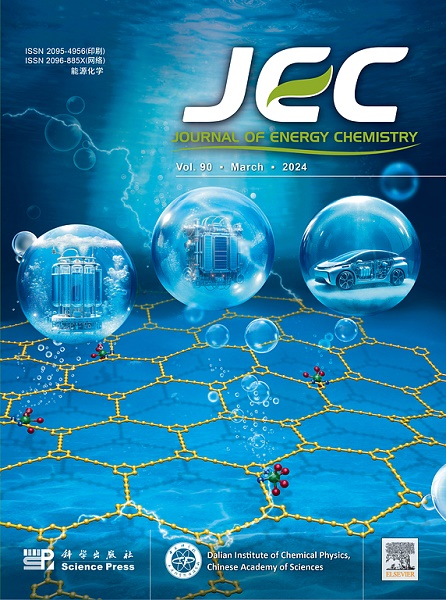Spatial distribution of oxygen vacancy on ceria catalysts for chemoselective synthesis of lignin-derived cyclohexanol
IF 13.1
1区 化学
Q1 Energy
引用次数: 0
Abstract
The synergy of metal/oxygen vacancy (Ov) pairs is critical in catalyzing activation of C–H, C=C, and C–O bonds. However, gaining fundamental understanding on spatial distance of metallic and Ov sites on catalyst surface would lead to unexpected chemoselectivity toward important and challenging reactions. In this work, we have proposed and validated unique Ni-O-Ce-Ov enriched Ni/CeO2 catalysts prepared by a deposition-precipitation method, for the transfer hydrogenation of lignin-derived guaiacol toward cyclohexanol rather than benzene derivatives. The counter-intuitively designed high Ni loading Ni20/CeO2 catalyst (20 wt% Ni content) displays a distance of 0.5 nm for Ni/Ov pairs with a remarkable activity (TOF: 166.5 h−1) and 90%+ selectivity for CAr=CAr bond saturation, outperforming better metal-dispersed Ni5/CeO2 catalyst with limited presence of Ni-O-Ce-Ov sites. The high hydrogenation activity against hydrogenolysis reactions on Ni20/CeO2 catalyst is attributed to tunable Ni/Ov distances, which constrain the cleavage of CAr–OH bond and deep deoxygenation. Such spatial distribution effect has also facilitated tandem dehydrogenation (O–H bond cleavage) and hydrogenation (CAr=CAr hydrogenation) reactions, leading to cyclohexanol as the target product in the absence of externally added H2. Insights into spatial distribution of Ov sites open an alternative perspective in designing efficient catalysts toward producing value-added cyclic oxygenates through upgrading of lignin compounds.

化学选择性合成木质素衍生环己醇催化剂上氧空位的空间分布
金属/氧空位(Ov)对的协同作用对催化活化C - h、C=C和C - o键至关重要。然而,对催化剂表面金属和Ov位点的空间距离的基本认识将导致对重要和具有挑战性的反应产生意想不到的化学选择性。在这项工作中,我们提出并验证了独特的Ni- o - ce - ov富集Ni/CeO2催化剂,通过沉积-沉淀法制备,用于木质素衍生的愈创木酚转移加氢制备环己醇而不是苯衍生物。设计的高Ni负载Ni20/CeO2催化剂(Ni含量为20 wt%)显示Ni/Ov对的距离为0.5 nm,具有显著的活性(TOF: 166.5 h−1)和90%以上的CAr=CAr键饱和选择性,优于Ni- o - ce -Ov位点有限的金属分散Ni5/CeO2催化剂。Ni20/CeO2催化剂的高加氢活性归因于可调节的Ni/Ov距离,该距离限制了CAr-OH键的裂解和深度脱氧。这种空间分布效应也促进了串联脱氢(O-H键裂解)和加氢(CAr=CAr加氢)反应,导致在没有外加H2的情况下,环己醇成为目标产物。对Ov位点空间分布的深入了解,为设计通过木质素化合物升级生产高附加值环氧化合物的高效催化剂提供了另一种视角。
本文章由计算机程序翻译,如有差异,请以英文原文为准。
求助全文
约1分钟内获得全文
求助全文
来源期刊

Journal of Energy Chemistry
CHEMISTRY, APPLIED-CHEMISTRY, PHYSICAL
CiteScore
19.10
自引率
8.40%
发文量
3631
审稿时长
15 days
期刊介绍:
The Journal of Energy Chemistry, the official publication of Science Press and the Dalian Institute of Chemical Physics, Chinese Academy of Sciences, serves as a platform for reporting creative research and innovative applications in energy chemistry. It mainly reports on creative researches and innovative applications of chemical conversions of fossil energy, carbon dioxide, electrochemical energy and hydrogen energy, as well as the conversions of biomass and solar energy related with chemical issues to promote academic exchanges in the field of energy chemistry and to accelerate the exploration, research and development of energy science and technologies.
This journal focuses on original research papers covering various topics within energy chemistry worldwide, including:
Optimized utilization of fossil energy
Hydrogen energy
Conversion and storage of electrochemical energy
Capture, storage, and chemical conversion of carbon dioxide
Materials and nanotechnologies for energy conversion and storage
Chemistry in biomass conversion
Chemistry in the utilization of solar energy
 求助内容:
求助内容: 应助结果提醒方式:
应助结果提醒方式:


